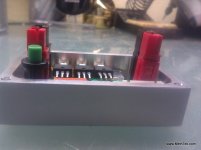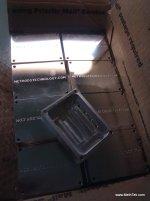methods
1 GW
I recently had a very interesting fellow come by the shop. We got to talking and decided machine up a batch of 50 aluminum housings that will allow us to re-purpose my HVC Breaker module into a Pack Level LVC Cutoff.
30V - 150V+ operation
~80A continuous current (this is somewhat arbitrary... I figure a bike might see peaks to 120A with an average of less than 50A)
Isolated housing that is fully encapsulated in epoxy
0uA draw after being tripped
This was our first prototype

View attachment 1

The idea would be to then fill in the void with epoxy.
After much talking and thinking about what the Motorcycle guys and ebike guys would want - we have changed our plans. The final product will be similar to what is above, but with the following changes:
* Board mount Andersons replaced with 10AWG silicone pigtails exiting out the side (controller style)
* Board mount button replaced with connectoized button (for relocation)
So as we stand today there would be a slot on the left or right side of the board.
The tentative plan is to line that slot with silicone, lay the wires in, lay another bead of silicone, then put the top on for curing. After the silicone has cured we will backfill the entire volume with epoxy. Purpose of the silicone being only to stop the epoxy from weeping out during potting. We want to avoid hot glue... but that would be another option.
For those seeing this for the first time - this module plugs into a hardware LVC/HVC detection system I have. If any one cell hits 3.0V this module would then break the battery connection in your system and lower system current draw to 0uA (it cuts its own power with a latching relay). That is the ebike application...
For the motorcycle guys they will want to place this between the charger and pack to have a high voltage, high current, high reliability HVC protection module that can terminate charge if any cell goes above 4.29V. Since many of them are running 1000A+ all of the HVC/LVC boards have a built in ability to do simple throttle retard.
So... this will be a limited run that I am going to let go at an affordable price. After this we will iron out the details, production-ify the process, and raise the prices to something sustainable.
A lot of you have been asking for something like this - A module that can completely terminate discharge on your battery even in the case where a controller is left on for weeks at a time. This should meet your requirements. At 50A constant discharge the assembly only warmed up by a few degrees C.
-methods
30V - 150V+ operation
~80A continuous current (this is somewhat arbitrary... I figure a bike might see peaks to 120A with an average of less than 50A)
Isolated housing that is fully encapsulated in epoxy
0uA draw after being tripped
This was our first prototype

View attachment 1

The idea would be to then fill in the void with epoxy.
After much talking and thinking about what the Motorcycle guys and ebike guys would want - we have changed our plans. The final product will be similar to what is above, but with the following changes:
* Board mount Andersons replaced with 10AWG silicone pigtails exiting out the side (controller style)
* Board mount button replaced with connectoized button (for relocation)
So as we stand today there would be a slot on the left or right side of the board.
The tentative plan is to line that slot with silicone, lay the wires in, lay another bead of silicone, then put the top on for curing. After the silicone has cured we will backfill the entire volume with epoxy. Purpose of the silicone being only to stop the epoxy from weeping out during potting. We want to avoid hot glue... but that would be another option.
For those seeing this for the first time - this module plugs into a hardware LVC/HVC detection system I have. If any one cell hits 3.0V this module would then break the battery connection in your system and lower system current draw to 0uA (it cuts its own power with a latching relay). That is the ebike application...
For the motorcycle guys they will want to place this between the charger and pack to have a high voltage, high current, high reliability HVC protection module that can terminate charge if any cell goes above 4.29V. Since many of them are running 1000A+ all of the HVC/LVC boards have a built in ability to do simple throttle retard.
So... this will be a limited run that I am going to let go at an affordable price. After this we will iron out the details, production-ify the process, and raise the prices to something sustainable.
A lot of you have been asking for something like this - A module that can completely terminate discharge on your battery even in the case where a controller is left on for weeks at a time. This should meet your requirements. At 50A constant discharge the assembly only warmed up by a few degrees C.
-methods






